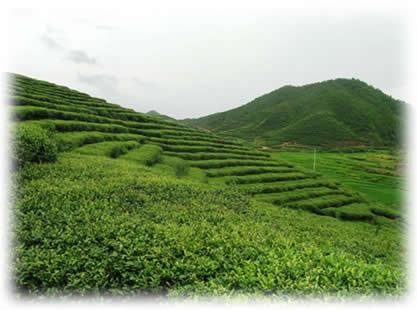White tea production
White teas are lightly fermented, yet least processed - no rubbing, shaping baking during their processing.
 The world's white tea production is highly concentrated in a pocket area of China, the Fuding and Zhenghe area of the north FuJian providence. (The plantation in the image is the source of our Fuding white tea - by a family of many generations of white tea farmers.)
The world's white tea production is highly concentrated in a pocket area of China, the Fuding and Zhenghe area of the north FuJian providence. (The plantation in the image is the source of our Fuding white tea - by a family of many generations of white tea farmers.)
The classic environmental conditions or the Fuding white tea plantations are: over 800 meters above sea level, temperature ranges between 15-23OC, humidity 80-90%, annual rain fall 1000-2000mm and red or yellow soil in mild acidic range.
There is also a limited production of a variation of white tea in the Yunnan province of China - the Yunnan white tea. The Yunnan white tea is made of tea leaves harvested from mainly arbor tea trees. The processing of the Yunnan white tea is similar to that of the Fujian white tea, but with a different tradition.
Apart from China, Darjeeling and Sri Lanka also have limited production of white tea of lower quality. As such the overall supply of premium white tea in the world is scarcer than many other teas.
 The Fujian white teas are made of leaves harvested from a particular tea plant specie called ‘Fu Ding Big White Fur’(福鼎大白毫), a special sub-specie of the Camilla Sinensis that has been carefully selected and cultivated over a long history to produce the premium Fujian white tea. One of the characteristics of these plants is that the leaves are big, strong and full with elegant needle shape tip leaves covered with the white fur.
The Fujian white teas are made of leaves harvested from a particular tea plant specie called ‘Fu Ding Big White Fur’(福鼎大白毫), a special sub-specie of the Camilla Sinensis that has been carefully selected and cultivated over a long history to produce the premium Fujian white tea. One of the characteristics of these plants is that the leaves are big, strong and full with elegant needle shape tip leaves covered with the white fur.
The early spring crops of these needle shape tip leaves are used to produce the top quality Fuding Silver Needle. The silver colour fur on the dry tea is where the 'Silver Needle' got its name from.
The second and third leaves drown the branch of the tea plants are also used for manufacturing white teas. These are known as white peony and ‘Tribute tea’ / ‘Eyebrow tea’ respectively. The white teas thus form a quality hierarchy in the sequence of: Silver Needle -> white Peony -> Shou Mei or ‘Tribute tea’ or ‘Eyebrow tea’.
White tea is one of the least processed teas. They are made by a relatively simple process of picking, withering and drying. The dry leaves largely preserve the shapes of the fresh leaves.
- Picking. There are detailed guidelines regarding the white tea picking, from timing of the season to the volume of leaves to pick depending on the age of the tea plants etc.
- The withering process is most crucial in the white tea's production, requiring careful assessment of the environmental conditions (season, sunlight, air temperature, wind and humidity etc) and controlling the withering process. It normally takes up to 2 days for the withering to complete. The light oxidization of the tea leaves happens naturally during this process and 70-80% of the moisture of the tea leaves evaporates by the end.
- The tea leaves are then spread into piles of certain thickness for a few hours to allow the necessary continuation and completion of the conversion of certain bio-active compounds.
- The tea leaves then go through a dehydration process to leave only approximately 5% moisture content in the final product.
The traditional method of white tea processing is time consuming and labor intense. New technologies and equipment have been developed to allow to complete the entire process indoor with precision control. Some traditional white tea farmers however continue to process their white teas in the natural environment, believing that this is the only way to achieve the traditional white tea flavor.


